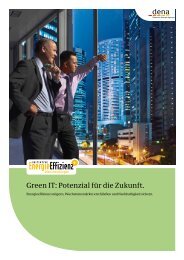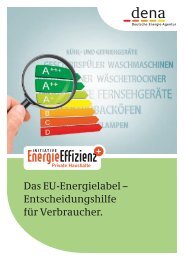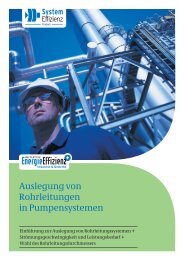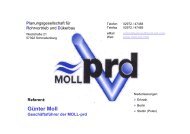biogaspartner – a joint initiative.
biogaspartner – a joint initiative.
biogaspartner – a joint initiative.
You also want an ePaper? Increase the reach of your titles
YUMPU automatically turns print PDFs into web optimized ePapers that Google loves.
Market.Development.in.Germany..<br />
Renewable.Energies.Heat.Act.(EEWärmeG)..<br />
next to the new EEG, the renewable Energies Heat act (EE-<br />
WärmeG) also became effective on january 1, 2009. according<br />
to this law, 14 percent of the German heat demand (final energy)<br />
is to be produced from renewable energy sources.<br />
Crucial elements of the law are:<br />
obligatory utilisation<br />
Financial promotion<br />
specific promotion of heating networks<br />
Buildings erected after january 1, 2009 are obliged to employ<br />
renewable energies for their heat supply. This obligation applies<br />
to all owners (private, state, economy). Exempted are buildings<br />
for which a building application or building listing has been issued<br />
before january 1, 2009. all forms of renewable energies can<br />
be used, also in combinations. When using biogas, the obligation<br />
is generally met if 30 percent of the heat energy demand of<br />
the respective house is covered by it. The biogas is to be used in a<br />
cogeneration plant in this context. In the case of the utilisation<br />
of gas taken from the gas grid, special requirements are binding<br />
regarding the conditioning and feeding-in. Methane emissions<br />
and power consumption must be abated “according to the<br />
best available technology”. In case of methane emissions this is<br />
usually accepted if the gas quality requirements of the Gas Grid<br />
Entry regulation (GasnZv) according to § 41f are met. The process<br />
heat needed for conditioning and feed-in must furthermore<br />
be produced from lost heat or renewable energy sources.<br />
22 B I o G a s P a r T n E r <strong>–</strong> a j o I n T I n I T I a T I v E<br />
Gas.Network.Access.Ordinance.(GasNZV).<br />
1. Preferred Network Access.<br />
according to § 41c of the Gas network access ordinance (German:<br />
Gasnetzzugangsverordnung, GasnZv), grid operators on<br />
all pressure levels are obliged to grant preferred grid access to<br />
plants which have put in a request. The grid access costs are split<br />
equally between the grid operator and the biomethane supplier.<br />
according to §41b GasnZv, the grid access consists of the<br />
connecting pipeline (up to 10 km), the gas pressure metering<br />
plant, the compressor and the calibrated measurement plant.<br />
The grid operator is the owner of the grid access and covers the<br />
costs of maintenance and operation.<br />
2. Preferred Network Entry.<br />
according to § 41d, 1 GasnZv, grid operators are to grant preference<br />
to biomethane transport clients when it comes to concluding<br />
entry and exit contracts, as long as these gases are compatible<br />
with the grid.<br />
The feed-in of biogas cannot, according to § 41d, 2 GasnZv, be<br />
denied by the grid operator under the premise of an existing<br />
capacity shortage. at the same time, the grid operator is obliged<br />
to take all necessary and economically sensible measures to<br />
ensure and optimise the admittance capacity.<br />
3. Extended Accounting Balance.<br />
For biogas transport clients, the GasnZv provides special regulations<br />
varying from part 7 in § 41e GasnZv on the extended<br />
accounting balance in biogas accounting. Especially in the<br />
summer months, there is usually a distinct difference between<br />
the biogas fed in and the biogas discharged. In order to balance<br />
the account, the transport client is categorised into an account-









